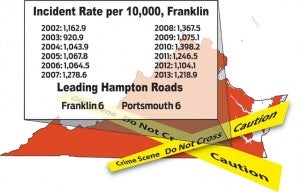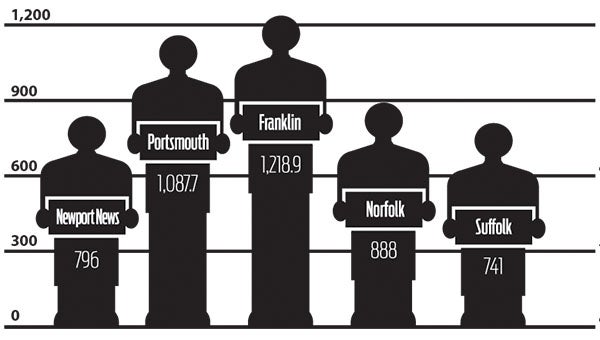Franklin leads Hampton Roads in VSP crime report
Published 11:23 am Saturday, December 20, 2014
FRANKLIN
When Franklin Police Department Capt. Tim Whitt presented the Virginia State Police’s annual crime report to a neighborhood watch group recently, he was a little shocked at what he was reporting.
“We have the second highest incident rate per capita in the state, which kind of surprised me,” Whitt said. “Obviously Norfolk has more violent crime in total, but the incident rate is lower than ours.”
Breaking it down
The incident rate is the number of incidents divided by population times 100,000, and for Franklin in VSP’s 2013 report, the incident rate is 12,189, which is only behind Roanoke. That city sits at 12,718. If you count small towns with populations under 500 people in these figures, only Glen Lyn’s is larger at 16,814. The town of 113 people had 19 incidents, which blew up their figures.
Now, thinking in terms of 100,000 people in Franklin doesn’t make a lot of sense. But if you scale it back to incidents per 10,000 people, the incident rate is 1,218.9 for Franklin. Comparatively, Portsmouth’s 1,087.7 per 10,000 manages to be the second worst rate per 10,000 in Hampton Roads behind Franklin.
Going out into Southampton County, the rate is 460, behind Smithfield’s 479.7. Windsor’s is 452 and Isle of Wight County comes in at 274.6, which is one of the lowest in the region. Surry’s, at 206, is the lowest.
Obviously, City Manager Randy Martin said, this is not a list Franklin wants to top.
“I am surprised we would rank that high in Virginia, but I am not shocked,” he said. “However, I would rather live here even if we do rank higher on the statistical analysis because of the instances and frequencies of more serious crime in some of the Hampton Roads communities, which is a lot more alarming to me. I feel safer here as a citizen.”
Looking at that statistical formula, as a single individual in 2013, you were 62.5 percent more likely to be assaulted in Franklin than you were in Norfolk.
In terms of murder and non-negligent manslaughter — the big crime — Franklin does not have one happen every year and did not in 2013. Going back to 2002, Franklin has had seven murders. While in 2013, Norfolk had 29 murders.
On the other hand, in 2012, Franklin had two murders, while Norfolk had 34. Per 10,000 people, the incident rate for murder in Franklin was 2.26, while Norfolk’s was 1.38. So while Norfolk had more murders total, a single person was around 60 percent more likely to get murdered in Franklin. Going further, Portsmouth’s 2013 rate was 1.2 murders per 10,000 people.
In Southampton County, there have been 11 murders since 2002, or an average of .9 per year. In 2009, the worst year, there were three murders, a rate of 1.66 per 10,000 people. Smithfield’s had three murders since 2002, the most recent one being 2012, and that year the rate was 1.2 per 10,000 people. There have been no reported murders from Windsor, but Isle of Wight Sheriff’s Office has reported nine since 2002. The worst year was 2012, which featured three murders, or an average rate per 10,000 people of 1.2.
Aggravated assault is an unlawful attack where a weapon is used or displayed in a threatening manner, or if the victim suffers severe bodily injury, such as broken bones or loss of teeth. Going back to 2002, there have been 256 aggravated assaults in Franklin, an average of 21 a year. The most was 2008, when there were 33. That year, Norfolk had 783, or about 33.3 per 10,000 people. In Franklin, 33 incidents in 2008 is 39.8 per 10,000 people. To be fair, Norfolk’s worst year during that period was 875 in 2007, which is a rate of 37.1 per 10,000 people.
Southampton County averaged 18.3 aggravated assaults per year, and the most was 32 in 2007. Per 10,000 people, that’s a rate of 19.4 per year. Smithfield’s rate for 2013 was 11.1, and Windsor’s was 19. In Isle of Wight County, the rate per 10,000 people in 2013 was 8.6 per year.
Adding to aggravated assaults, Franklin has decreased that number since 2008. From 2002-2008, the average number of aggravated assaults per year was 25.3, while from 2009-2013, that number was 15.8. The rate per 10,000 people is 29.2 for the first seven years, and 18.3 for the latter five, which does compare with Southampton County’s worst year. However, if you give Southampton the same five-year period, 2009-2013, the county’s rate is 9.6 per 10,000 people.
On topic of the bigger crime, though, murder has occurred more frequently during the 2009-2013 time period for Franklin. There were three murders from 2002-2008, and four from 2009-2013. Simple assaults have also gone up. There were an average of 261 from 2002-2008 and an average of 279 from 2009-2013.
The other part of the violent crime spectrum, sex crimes — forcible rapes and other forcible sex offenses — there are approximately 10 per year. From 2002-2008, that number was 7.6 per year. From 2009-2013 there was an average of 13.2 forcible rapes and other forcible sex offenses per year. Of those numbers, there were an average of two rapes per year from 2002-2008 and an average of 6.4 from 2009-2013.
Franklin had nine rapes in 2013, while Norfolk had 82. That’s an incident rate of 3.3 per 10,000 in Norfolk and 10.1 in Franklin.
In Franklin’s backyard, the rate for rape is 1.6 per 10,000 people in Southampton County for 2013, 1.2 in Smithfield, and 0 in Windsor. In Isle of Wight County, the rate is 1.2 per 10,000 people for 2013.
Counting robbery among the other property crime figures, which includes burglary, larceny, motor vehicle theft, stolen property and destruction/damage/vandalism, Franklin has had an average rate of 665.1 of these types of crimes per year since 2002. And that’s gone up from a rate of 630.1 per year from 2002-2008 to 714 per year from 2009-2013.
Out of these, burglaries have increased from 56.4 per year from 2002-2008 to 88 per year from 2009-2013. Larcenies, which is taking something in plain sight, such as shoplifting, stealing a lawnmower from a front yard or taking a gun from the front seat of a car, have also increased, from 290 per year in 2002-2008 to 337.4 per year from 2009-2013. Destruction/damage/vandalism has also increased, while motor vehicle theft and people being arrested with stolen property has decreased, which isn’t necessarily a good thing.
To compare, Franklin had 101 burglaries in 2013, while Norfolk had 2,035. Per 10,000 people, Norfolk’s rate is 82.6, and Franklin’s is 116.7.
Closer to home, Southampton County’s rate for burglaries per 10,000 is 62.8, Isle of Wight’s is 28.1, Smithfield’s is 22.1 and Windsor’s is 15.2, all of these figures for 2013.
Drugs and narcotics violations have been a constant during the time period, 80.6 per year from 2002-2013, as have weapon law violations at 32.7 per year. Per 10,000, that average is 93.1 per year for drugs, and 37.8 for weapon law violations. In Norfolk, in 2013, the rate per 10,000 for drugs was 71.3 and weapons was 6.4.
In Southampton County for 2013, the rate per 10,000 for drugs was 48 and weapons 7.6. Windsor’s rate for drugs was 91.3 and 3.8 for weapons. In Smithfield, the rate was 84.9 for drugs and 6.2 for weapons per 10,000.
Martin said the numbers might be skewed slightly in a formula like that for a city of smaller population, such as Franklin at about 8,600. While this might be true that a large city — such as Norfolk with a population of about 246,400 — has a size advantage to absorb some of the numbers, Franklin still does not compare favorably to Isle of Wight County, at about 25,400, Southampton County, 18,300, Smithfield, 8,100, or Windsor, 2,600. There are more weapons, more drugs, more property crimes, more rapes, more assaults and more murders.
Root causes
Franklin Police Chief Phil Hardison said he wasn’t surprised to see the way crime numbers compare in the region. He emphasized that the crime is only reported crime, though he admitted that Franklin’s non-reported crime may be similar to that of Portsmouth’s in a statistical measure such as the VSP report.

This represents the history of Franklin’s incident rate, according to the crime reported to the Virginia State Police from 2002-2013 — Cain Madden | Tidewater News
In talking about what typically drives crime in a community, he pointed to several root causes: public housing and rental housing versus home owners, high school dropout rate, poverty, teen pregnancy, mental health and substance abuse (drugs and alcohol).
Hardison said every community in the country faces problems like this when it comes to crime. However, he suspects that Franklin is, uniquely for Western Tidewater, on the wrong end of every single one of those categories.
According to 2012 Census data, of the 3,551 occupied homes and apartments in Franklin, 57.5 percent of them are going to renters. Of Smithfield’s 3,260 occupied dwellings, that renter percent is 25.8. The Virginia average is 32.7 percent going to renters.
In Franklin, 20.6 of the population doesn’t have a high school diploma or a GED. In Smithfield, it’s 10.4 percent of the population. The average for Virginia is for 12.6 percent of the population to not possess a high school diploma or GED.
According to the 2012 Census data, 23 percent of the population lives below the poverty line in Franklin. In Smithfield, 13.3 percent of the population lives below poverty, and around the state, that figure is 11.3 percent.
Concerning the youth, in 2013 the rate per 1,000 teenage pregnancies is 42.7. In Southampton County, that rate is 7.4, and it’s 12.8 in Isle of Wight County. Norfolk’s is 31 and the Virginia average is 14.3 per 1,000 teenage pregnancies.
For Franklin, that teenage pregnancy rate is actually down from more than 60 per 1,000 in the year 2009, but 2013’s rate is still 33.5 percent higher than the state average.
In terms of state mental health facility bed days, The Tidewater News was unable to obtain numbers for Franklin specifically. However, in Western Tidewater, 8,749 bed days were used by mental health patients in 2013. In Virginia, the total was 450,052.
The population for Western Tidewater, including Isle of Wight County, Suffolk, Franklin and Southampton County was approximately 140,500. The number of mental health patient bed days is approximately 6 percent of the population of Western Tidewater. The population of Virginia is 8.26 million, and the percent of patient bed days is approximately 5 percent of that number.
Considering mental health in Franklin, FPD responded to 81 mental subject calls in 2013. Dr. Nancy Welch of the Western Tidewater Health Office said that there is an association with unstable or untreated mental illness with crime and homelessness. In terms of access to health care through insurance, statistics from 2011 show that Franklin and Southampton County were worse than the state average, while Isle of Wight was doing better.
As mentioned previously, the number of drug violations was higher for Franklin than other local areas. As far as alcohol, from Dec. 8, 2013 to Dec. 8, 2014, in Franklin, there were 37 reported DUIs and 47 alcohol violations. Counting Franklin and Southampton County during that period, there were 85 DUIs and 51 alcohol violations.
This list of issues is way bigger than law enforcement, Hardison said.
“When I talk about crime prevention, I talk in terms of almost by environmental design,” he said. “What do you want your community to look like? I’m talking in terms of a planing and zoning perspective — rental housing and public housing, educational opportunities, substance abuse issues and mental health issues. These are areas way outside of the scope of law enforcement.
“We just end up dealing with the by-product of all of these things.”
In that case, Hardison said it wasn’t the amount of money or officers you throw at it in terms of dealing with the crime.
“People equate adding police officers with less crime,” he said. “If I added 10 officers, all they are dealing with is the immediate instantaneous crime in progress issue and we can end up responding to calls in greater numbers. But all of that is reactionary. You still haven’t done anything to address the quality of life.”
Hardison said that to really fix the problem of crime, you’ve got to have the entire community working toward it — city government, civic groups, neighborhood watch groups, the schools, and everyone in between.
“It will take a lot of complex discussion by some very educated people and practitioners seeking solutions full time, rather than just the 30 policemen who are held responsible and accountable for all of the wrongs someone else commits,” he said. “When talking about crime, it will take law enforcement, people in the criminal justice system and the leaders of the city.”
Martin said he was proud of the police department and what they have been able to accomplish.
“I think our chief and staff do an excellent job with the resources that we have of fighting crime, and fighting crime is a war,” he said. “But one thing that I have been real pleased with is they have a good success rate in arrests in major crimes.
“I know our police department has focused on working with federal courts and trying to do federal prosecution for the more serious crime. That has awarded a higher conviction rate and stiffer sentences.”
Down the line, Martin thought, that might make a difference, particularly with people coming from the Hampton Roads cities to cause trouble. Once out-of-town criminals understand this reputation, he thinks some of the organized crime coming from the major urban areas will decrease.
Phone calls to Mayor Raystine Johnson-Ashburn about this issue were not returned.
It’s not enough, though
Hardison emphasized that he’s proud of what his officers have been able to do, and he said they are well-trained and absolutely dedicated to the community. He also says the department has received a lot of help over the years from local charities, which has aided in obtaining equipment they may have not been able to get otherwise. The city and charities have also helped recently with upgrading the communications system.
“It is the city in which we live, where we want to raise our children, and you always want a very safe community,” Hardison said. “As a police department, given the resources that we have, in terms of the number of personnel that we are allotted, I think our personnel do an exceptional job. I am very proud of the job they do and the way they do it.”
However, there are issues. For example, the city only allots FPD 30 sworn officers. The police chief said he knows there are serious budget constraints where it concerns the city. Hardison also said he hopes that in future budget talks Franklin can do more catching up with other law enforcement agencies rather than falling behind.
With the call volume they get, Hardison said 30 is not enough. In comparison, Franklin had 27 sworn officers in 2013, Southampton 65, Isle of Wight 47, Smithfield 20 and Windsor 6.
Franklin had 39 serious incidents in 2013 for every officer; Southampton – 13; Isle of Wight – 15; Smithfield – 19; Windsor – 20. Norfolk had 29 serious incidents in 2013 for every officer.
Recruitment’s also an issue. Martin said the salary and benefit package is not competitive with the region, particularly Hampton Roads.
While Hardison said he does retain most of his officers for a number of years, some do get trained by Franklin and move on to higher-paying jobs with a lesser call volume per officer.
“Law enforcement, by nature, has been a highly transferable skill from one organization to the next,” he said, and the chief added that he’d rather have an officer who is educated and well-trained that leaves, as compared to having officers who are not well-trained and lazy that stick around.
“There are a couple of reasons as to why your good people stay, and I think people with very strong values, who are value-driven are more likely to be committed, particularly if they share the values of the organization. It becomes contagious, and it also develops an organizational reputation of expectations from the community.”
Working with what they have, the short-term goal for the Franklin Police Department is to identify the members of the community that adversely affect the quality of life for the community — the most violent offenders — and produce them for the courts.
“We have an overwhelming percentage of our population that are extremely hard-working, well-intended, law-abiding people,” Hardison said. “There’s no question of that in my mind, or I would not want to live here myself. But we have a small percentage of people that are not of lawful intent, that have the ability to manipulate and cultivate a lot of fear, and they can have a damaging impact on a community.”
Long-term, the goal is to get ahead of the crime and deliver a more intelligence-level driven police unit. Intelligence-level policing is using law enforcement resources to educate and interact with the public at a less intrusive level. To get there, though, Hardison said something had to be done about the root problems creating the crime, such as substance abuse, public and rental housing percent and the other drivers.
There are several reasons why drugs or alcohol can become problematic for officers. It can impact burglaries, as people seek to steal to get by or get more drugs.
When people commit these crimes under the influence, it can become even worse. Hardison said what was intended to be a robbery can quickly become a rape or even a murder if someone’s judgment is impaired.
Hardison said most people who are living in public housing, or renting an apartment are good people. But he added there are some people who are not well-intentioned folks there, people who may not even live in Franklin full-time.
“Think about the young people who dropped out of high school, and they might have a problem with drugs, and they are unemployed,” Hardison said. “Where are they going to live? How are they going to live? If someone came up to you, and you were in that situation, uneducated, no job, and he said you can make $50 an hour just to stand on that corner at these times, would you take it?
“When I first got here, working undercover, one of the first people I bought drugs from was a 13-year-old making $25 an hour from someone in Portsmouth, just to sell dope in Franklin because of the odds of getting caught. He was making more money per hour, at 13, than his mother.”
Hardison said lower-income housing projects are a place where people who are struggling to make it can connect with people who are up to no good.
“There’s nothing wrong with lower-income housing — the majority of people who live there are good people,” he said. “The problem with it is when it is disproportionate to the size of the area.”
Martin said it’s a battle that you can never win — crime’s been around since the dawn of humanity, and it’s not going anywhere. Police, on a daily basis, battle the problem of gangs, and they, along with the schools and parents, battle the influence of drugs and gangs on youth. The economy is also a factor, as property crime has increased.
“It comes in waves,” Martin said. “You are going to have good years, and you are going to have bad years.”
Martin said he didn’t blame anyone for it.
“It’s human nature to point the finger, but I don’t blame the citizens. I don’t blame the police department,” he said. “There’s just an element of people in every group that wants to do it the easy way, or more so, not the hard-working way.
“It’s a battle that we are not likely to win, one that we just hope to get better at, and maybe prevail more often than you lose.”
At the end of the day, if you want it to get better, Hardison said that the community, over time, would have to get together and talk about it — Franklin needs to talk about how it wants to fix the root problems of crime, which he said are out of proportion in the city.
“This isn’t a one answer fits all type of thing,” the chief said. “But I think if we start to answer and address those elements as a whole, we can start to effect in a positive fashion public safety for this city, for this area.”






